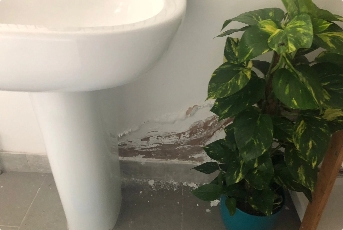Rising Damp: Causes, Signs & Effective Prevention
Damp and mould are a serious threat to UK properties, especially in London and the south, where clay is present and that stops water from draining away. Rising damp specifically comes up from the ground and using a capillary action, moisture can rise up brickwork and masonry, causing damage to the building. Every structure should have a damp proof course, which is about 5mm in thickness and it is sandwiched between courses of bricks to prevent moisture crossing the barrier.
What causes rising damp?
Damp rises up walls if the damp proof course (DPC) is damaged or not present, hence the term ‘rising damp’; if the DPC is defective, it doesn’t take long for moisture to invade the building. Damp that enters a building from other locations is known as penetrating damp, rising damp comes from the ground. Victorian properties often have a damp issue because the DPC degrades and finally breaks down. There are several ways to deal with defective DPC; a popular solution is injectable DPC, which is a type of foam and when injected into a cavity wall, it prevents rising damp.
Tell-tale signs of rising damp
On the exterior walls, a sign of moss or mould growth is an indication that moisture is present within the material; if you find areas, take a screwdriver and poke at the bricks/mortar to see if it is crumbling and if so, you have defective DPC and that needs to be resolved before the damage is repaired.
Interior signs of rising damp
Signs of rising damp include damp patches on walls and ceilings, discolouration, peeling wallpaper and bubbling paint; check all timber fittings, namely skirting boards, architrave and timber window frames. Woodworm, wet and dry rot are also a threat to timber, so make sure to inspect all interior timber structures.
How to prevent rising damp
As mentioned above, rising damp comes from the ground and the DPC must be defective, otherwise damp cannot jump across the barrier. You should call in London Damp Specialists and one of our certified damp surveyors would identify the source of the moisture and recommend effective remedial work. Time is of the essence when it comes to moisture penetration, so we would schedule the work in a timely fashion.
Damp proofing injection
A special foam can be injected into cavity walls and when it sets, it is a barrier that moisture cannot penetrate. Another solution is to install a new DPC membrane, which is quite a complex job. We at London Damp Specialists issue a full 30-year warranty on all completed work, which is a reflection of our high standard of workmanship.
We specialise in treating rising damp, so call us on 020 7458 4864 or fill in the online form on this website and we can arrange for one of our certified damp surveyors to inspect your home. Along with a detailed survey report, you will receive an all-inclusive quote for remedial work that we recommend.
